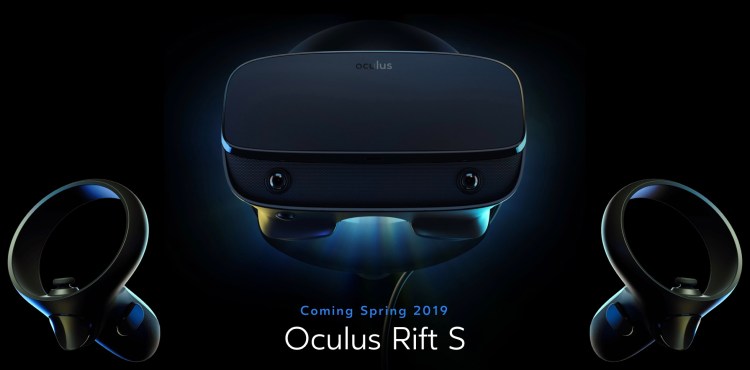After months of rumors and a somewhat damning leak, Facebook’s Oculus division today made the Oculus Rift S official as its follow-up to 2016’s Oculus Rift. The Rift S is solely for use with Windows 10 PCs, and we have tons of additional details and insight in our announcement story and Oculus interview.
As the “S” name suggests, the new model is not a big enough step forward to qualify as Oculus Rift 2, but does make a number of improvements to the original model. Many are innovations originally pioneered for the Oculus Go and Oculus Quest standalone headsets.
One thing that’s hard to come by for the Rift S is a straight spec-for-spec comparison, so we’ve put together a convenient table so you can see what’s changed between the models. It’s not all good news: The Rift S actually has a lower refresh rate than the Rift, and fixed rather than adjustable lenses, though the resolution and tracking systems have seen some noteworthy upgrades. Take a peek at the details below.
Oculus Rift S vs. Oculus Rift
| Oculus Rift S | Oculus Rift | |
|---|---|---|
| Resolution | 2560×1440 (1280×1440 per eye) | 2160×1200 (1080×1200 per eye) |
| Pixel Density | Approx. 600ppi | 456ppi |
| Screen Type | LCD | Pentile AMOLED |
| Refresh Rate | 80Hz | 90Hz |
| Field of View | Approx. 115° | 110° |
| Optics | Second-gen hybrid Fresnel lenses Decreased screen door effect Decreased god rays |
Hybrid Fresnel lenses |
| IPD | Fixed 64mm | Variable 58-71mm |
| Sensors | Accelerometer Gyroscope Magnetometer |
Accelerometer Gyroscope Magnetometer |
| Tracking | Integrated room-scale 6DoF inside-out Oculus Insight 5-camera sensor internal tracking |
Non-room scale by default 6DoF external Constellation camera 360-degree IR LED head tracking |
| Mixed Reality | Passthrough+ (True stereo-correct viewer) |
Passthrough (Non-stereo-correct viewer) |
| Headphones | Oculus Go/Quest near-ear speakers Headphone jack |
“3D audio” headphones Headphone jack |
| Design Twists | Lenovo designed with Halo strap Improved comfort Improved light blocking Single cable connection |
First model |
| Connectivity | DisplayPort 1.2, USB 3.0 (5-meter) | HDMI 1.3, USB 3.0 (4-meter headset), USB 2.0 |
| Controllers | Oculus Touch with 360-degree tracking support | Oculus Touch with 180-degree front-facing tracking support |
| Requirements | Intel i3-6100 or AMD Ryzen 3 1200, 8GB RAM, Nvidia GTX 1050Ti or AMD Radeon RX 470 | Intel i3-6100 or AMD Ryzen 3 1200, 8GB RAM, Nvidia GTX 1050Ti or AMD Radeon RX 470 |
| 1 USB 3.0 Port | 1 USB 3.0 and 2 USB 2.0 ports | |
| Weight | Unknown, but “better distributed” than Rift | 470g |
| Release Date | Spring 2019 | March 28, 2016 |
| Current Price | $399 | $349 |
Specs obviously only tell part of the story, and Oculus hasn’t released official numbers for everything we’d like to compare. On a positive note, the company deliberately avoided raising the PC requirements for Rift S, so machines (and games) that work with Rift will work with the new model. But the headset may be a little heavier than before, even if its weight is distributed better on your head.
The company isn’t yet taking preorders or orders for Rift S, though the spring release is expected to be “imminent.” In the meanwhile, check out our news coverage of Rift S here, and our interview with Oculus head Nate Mitchell here.

